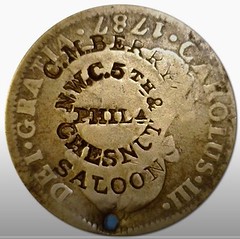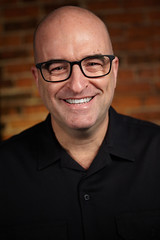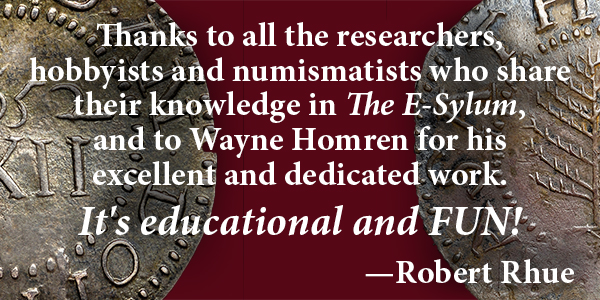
PREV ARTICLE
NEXT ARTICLE
FULL ISSUE
PREV FULL ISSUE
BILL GROOM INTERVIEW, PART ONEGreg Bennick's latest interview for the Newman Numismatic Portal is with counterstamp researcher Bill Groom. Here's the first of four parts. -Editor
Greg Bennick Introduction
Interview
Greg Bennick Hi, everybody. My name is Greg Bennick. I am with the Newman Numismatic Portal. I do interviews for them and today I'm going to be interviewing Bill Groom. Bill is an expert on counter stamps. We're going to dive right into a conversation about this area of numismatics. Bill, Hi, how are you doing today? Bill Groom Hi, Greg. I don't know if it's fair to call me an expert. I might have some expertise though. Greg Bennick That that works for me and that works for all of our listeners too. So that's perfect. I was going to ask, what is a counterstamp? How were they used and when were they most popular in terms of their production?
Bill Groom
Well, counterstamping actually goes back to ancient times. Coins were re-denominated
with different rulers. And anyway, I focus mainly on U.S. merchant counterstamps and they
were….coins were stamped for a great variety of reasons, some as little billboards as Greg
Brunk noted to advertise their business or service, their products. Sometimes coins were
counterstamped by inventors testing their patent stamps. Coins were stamped for, gosh,
dozens of reasons. I made a long list of why coins were stamped at one time, and I don't
know if I broached that or not. I don't recall. But then to answer the second part of your
question, in the 1850s counterstamping kind of exploded on the scene there - gunsmiths
silversmiths, were the most commonly seen, but also there were taverns, all number of
occupations. Early photography was starting and people taking pictures and framing them
and selling them. And oftentimes many of them stamped their frames. Gunsmiths stamped
their guns, and cutlers stamped their knives. So the list goes on and on. And the coins
sometimes were made for family members or friends or customers that have a coin. And
the merchant would stamp it for them and they would have it in their pocket. And to show
other people, Greg Bennick This is amazing. So basically, you're describing a situation where counterstamps are used as business cards, as calling cards, as souvenirs or as essentially gifts sometimes. And you mention, of course, there being merchant counterstamps. There's others as well. And I know you mentioned going back throughout history, others and just for a moment, I figured we touch on, soldier ID tags. Were there other things that they were used for as well? And also, overall, what are the populations like per piece? Meaning if it was just a merchant, a gunsmith, say, or a photographer, how many of these were made? Bill Groom Well, there were some people who stamped coins almost endlessly. And like one of them, Dave Bowers wrote about Dr. George Wilkins in Pittsfield, New Hampshire, and he just stamped a great number of coins. I highly recommend that book to anyone – it's about the mysterious Dr. Wilkins. He was a dentist, but he had some other interests, too. He liked to tip the bottle a bit. But Dave has some interesting observations about this fellow. But to answer your question, we had discussed beforehand, and I looked at my database about the populations of counterstamps. I checked out my database last night, and as of last night, I had 2753 counterstamps listed in my database. Now, some of them, many of them, are multiple pieces of the same individual who issued them. But out of that 2753, I counted 2058 pieces that there were less than 15 or fewer specimens known of that particular counterstamp. Huge numbers of people stamped coins, but very limited numbers of coins generally. Greg Bennick So other than merchants, I mentioned soldier ID tags. Were they used for other things as well? Or was it mainly merchant use throughout the - you said the 1850s - and beyond. Bill Groom Okay. All right. For the soldier I.D. tags I've only ever seen and owned one of those. Soldier I.D. tags were produced by sutlers on medallion pieces, not really on coins. So it wasn't it wasn't really a counterstamp per se. A counter stamp would be stamping upon a coin. But these were stamped medals that were carried by soldiers. But as far as the coins go, there's only one that I've ever known. There are a couple that look similar that could possibly be soldiers counterstamps, but I only own one that actually resembles the die struck ones. There were stamping kits that they had to do on those. I wrote the author of a book on those, and he never gave me a reply on it, but I was trying to investigate if he had seen any. But he has none listed in his book. So that really wasn't a common occurrence. Very uncommon. Very rare.
Greg Bennick
Now, you've referred to counterstamps in your emails with me as,
Bill Groom
Oh, yes, pretty much. And what I also meant was this is a frontier that really bears
exploration and discovery. And it's wide open because there are thousands and thousands
of counterstamps out there that have yet to be researched and identified. And that is the
frontier – its really is getting to those pieces. And I know one of the things concerns me is
that people will look at a book and they'll take a book once something is in print as gospel,
or if it's on a slab and says such and such on a slab. Well, that's it. That's what it is. Well,
that's not the case. Many pieces have been misattributed. And that's a problem. The
Greg Bennick
So this is interesting. It's like the adage of Bill Groom Yes, that's that's very true. And do you do your research on these before you buy them. And one of the things that's nice about coins and buying coins at auction is you have days to actually research the pieces. And I bought many counterstamps at auction. And the best buys are often in bulk lots because the auction houses just throw a number of pieces in there and they're not really - there's no attention or very little of any attention given to attribution of the pieces. And I got some tremendous bargains buying in bulk lots. A couple in the Patrick auction that was held not long ago. And some from Stacks. And it's just it's a way to get counterstamps is to buy a whole deal of a group of them. And that's something your collectors should look for. I don't need the competition, but that's the way it is. I've got more than enough of the counterstamps so… share the wealth.
To watch the complete video, see:
To read the complete transcript, see:
To read the earlier E-Sylum article, see:
Wayne Homren, Editor The Numismatic Bibliomania Society is a non-profit organization promoting numismatic literature. See our web site at coinbooks.org. To submit items for publication in The E-Sylum, write to the Editor at this address: whomren@gmail.com To subscribe go to: https://my.binhost.com/lists/listinfo/esylum All Rights Reserved. NBS Home Page Contact the NBS webmaster 
|


